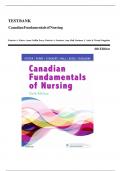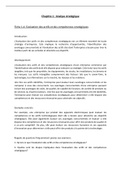TEST BANK b
Canadian Fundamentals of Nursing
b b b
Patricia A. Potter, Anne Griffin Perry, Patricia A. Stockert, Amy Hall, Barbara J. Astle & Wendy Duggleby
b b b b b b b b b b b b b b b b
6th Edition
b
,Table of Contents
b b
Chapter 01 Health and Wellness
b b b b 2
Chapter 02 The Canadian Health Care Delivery System
b b b b b b b 11
Chapter 03 The Development of Nursing in Canada
b b b b b b b 19
Chapter 04 Community Health Nursing Practice
b b b b b 25
Chapter 05 Theoretical Foundations of Nursing Practice
b b b b b b 34
Chapter 06 Evidence-Informed Practice
b b b 40
Chapter 07 Nursing Values and Ethics
b b b b b 48
Chapter 08 Legal Implications in Nursing Practice
b b b b b b 56
Chapter 09 Global Health
b b b 67
Chapter 10 Indigenous Health
b b b 75
Chapter 11 Nursing Leadership, Management, and Collaborative Practice
b b b b b b b 83
Chapter 12 Critical Thinking in Nursing Practice
b b b b b b 91
Chapter 13 Nursing Assessment, Diagnosis, and Planning
b b b b b b 99
Chapter 14 Implementing and Evaluating Nursing Care
b b b b b b 110
Chapter 15 Documenting and Reporting
b b b b 121
Chapter 16 Nursing Informatics and Canadian Nursing Practice
b b b b b b b 135
Chapter 17 Communication and Relational Practice
b b b b b 142
Chapter 18 Patient-Centred Care Interprofessional Collaborative Practice
b b b b b b 154
Chapter 19 Family Nursing
b b b 161
Chapter 20 Patient Education
b b b 175
Chapter 21 Developmental Theories
b b b 187
Chapter 22 Conception Through Adolescence
b b b b 196
Chapter 23 Young to Middle Adulthood
b b b b b 206
Chapter 24 Older Persons
b b b 215
Chapter 25 The Experience of Loss, Death, and Grief
b b b b b b b b 226
Chapter 26 Self-Concept
b b 236
Chapter 27 Sexuality
b b 244
Chapter 28 Spirituality in Health and Health Care
b b b b b b b 253
Chapter 29 Stress and Adaptation
b b b b 261
Chapter 30 Vital Signs
b b b 269
Chapter 31 Pain Assessment and Management
b b b b b 286
Chapter 32 Health Assessment and Physical Examination
b b b b b b 302
Chapter 33 Infection Control
b b b 317
Chapter 34 Medication Administration
b b b 335
Chapter 35 Complementary and Alternative Approaches in Health Care
b b b b b b b b 350
Chapter 36 Activity and Exercise
b b b b 358
Chapter 37 Quality and Patient Safety
b b b b b 370
Chapter 38 Hygiene
b b 382
,Chapter 39 Cardiopulmonary Functioning and Oxygenation
b b b b b 401
Chapter 40 Fluid, Electrolyte, and Acid–Base Balances
b b b b b b 417
Chapter 41 Sleep
b b 433
Chapter 42 Nutrition
b b 441
Chapter 43 Urinary Elimination
b b b 457
Chapter 44 Bowel Elimination
b b b 472
Chapter 45 Mobility and Immobility
b b b b 485
Chapter 46 Skin Integrity and Wound Care
b b b b b b 503
Chapter 47 Sensory Alterations
b b b 523
Chapter 48 Care of Surgical Patients
b b b b b 534
, Test Bank - Canadian Fundamentals of Nursing, 6e (Potter, Perry, 2019)
b b b b b b b b b b
Chapter 01: Health and Wellness
b b b b
Potter et al: Canadian Fundamentals of Nursing, 6th Edition
b b b b b b b b
MULTIPLE CHOICE b
1. The nurse is using the population health promotion model to develop actions for
b b b b b b b b b b b b
improving health. After asking, “On what should we take action?”; “How should we take
b b b b b b b b b b b b b b
action?”; and “Why should we take action?” the nurse will ask which of the following
b b b b b b b b b b b b b b b
questions?
b
a. “With whom should we act?” b b b b
b. “When should we take action?” b b b b
c. “Which government should take action?” b b b b
d. “Where should we first act?” b b b b
ANS: A b
The next question to ask when using the population health model approach is “With whom
b b b b b b b b b b b b b b
should we act?” The other choices are not questions included in this model.
b b b b b b b b b b b b b
DIF: Apply REF: 13 (Figure 1-5) b b b
OBJ: Contrast distinguishing features of health promotion and disease prevention.
b b b b b b b b b
TOP: Implementation bb MSC: NCLEX: Health Promotion and Maintenance b b b b b
2. The principle “Health promotion is multisectoral” means which of the following?
b b b b b b b b b b
a. Relationships between individual, social, and environmental factors must be b b b b b b b b
recognized.
b
b. Physical, mental, social, ecological, cultural, and spiritual aspects of health must
b b b b b b b b b b
be recognized.
b b
c. In order to change unhealthy living and working conditions, areas other than health
b b b b b b b b b b b b
must also be involved.
b b b b
d. Health promotion uses knowledge from disciplines such as social, economic,
b b b b b b b b b
political, environmental, medical, and nursing sciences, as well as from first-hand
b b b b b b b b b b b
experience.
b
ANS: C b
The statement “Health promotion is multisectoral” is the principle explained by the
b b b b b b b b b b b
necessity to involve areas other than health in order to change unhealthy living and
b b b b b b b b b b b b b b
working conditions.
b b
DIF: Understand REF: 11 b
OBJ: Contrast distinguishing features of health promotion and disease
b b b b b b b b
prevention. TOP: Planning
b MSC: NCLEX: Health Promotion and
b b b b b b b
Maintenance
b
3. According to the World Health Organization, what is the best description of “health”?
b b b b b b b b b b b b
a. Simply the absence of disease. b b b b
b. Involving the total person and environment. b b b b b
c. Strictly personal in nature. b b b
d. Status of pathological state. b b b
ANS: B b
1|Page
b b b b b






